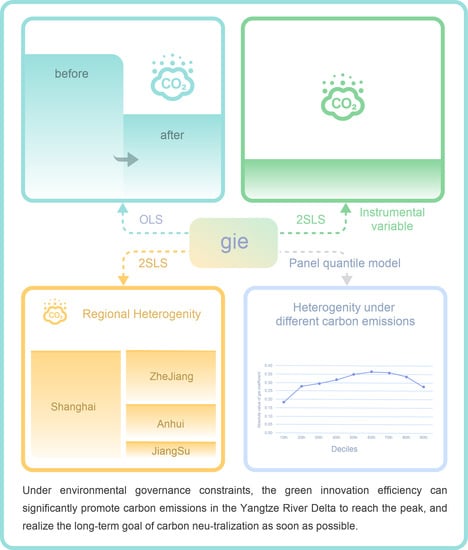Impact of Green Innovation Efficiency on Carbon Peak: Carbon Neutralization under Environmental Governance Constraints
Abstract
:1. Introduction
2. Literature Review
2.1. Foreign Literatures Review
2.2. Chinese Literature Review
3. Research Hypothesis
4. Research Methods and Index Measurement
4.1. Research Methods
4.1.1. Undesirable-Super-SBM Model
4.1.2. Two-Stage Least Squares Estimation Method
4.1.3. Panel Quantile Regression
4.2. Index Measurement
4.2.1. Carbon Emissions Calculation
4.2.2. Green Innovation Efficiency
4.3. Data Sources
5. Carbon Emission of Urban Agglomeration in Yangtze River Delta
5.1. Overall Status of Carbon Emissions in Yangtze River Delta Urban Agglomeration
5.2. Analysis of Carbon Emissions in Three Provinces and One City of Yangtze River Delta
6. Empirical Analysis
6.1. Analysis of Benchmark Regression Results
6.2. Endogeneity Test
6.3. Robustness Test
6.4. Heterogeneity Analysis
6.4.1. Regional Heterogeneity
6.4.2. Heterogeneity under Different Carbon Emissions
7. Research Conclusions and Policy Recommendations
7.1. Research Conclusions
7.2. Policy Recommendations
7.3. Limitations and Prospect
Author Contributions
Funding
Institutional Review Board Statement
Informed Consent Statement
Data Availability Statement
Conflicts of Interest
References
- Eyring, V.; Cox, P.M.; Flato, G.M.; Gleckler, P.J.; Abramowitz, G.; Caldwell, P.; Collins, W.D.; Gier, B.K.; Hall, A.D.; Hoffman, F.M. Taking climate model evaluation to the next level. Nat. Clim. Chang. 2019, 9, 102–110. [Google Scholar] [CrossRef]
- Quéré, C.L.; Korsbakken, J.I.; Wilson, C.; Tosun, J.; Vuuren, D. Drivers of declining CO2 emissions in 18 developed economies. Nat. Clim. Chang. 2019, 9, 213–217. [Google Scholar] [CrossRef]
- Martinich, J.; Crimmins, A. Climate damages and adaptation potential across diverse sectors of the United States. Nat. Clim. Chang. 2019, 9, 397–404. [Google Scholar] [CrossRef] [PubMed]
- Cheng, Y.; Wang, Z.; Ye, X.; Wei, Y.D. Spatiotemporal dynamics of carbon intensity from energy consumption in China. J. Geogr. Sci. 2014, 24, 631–650. [Google Scholar] [CrossRef]
- Queré, C.L.; Peters, G.P.; Andres, R.J.; Boden, T.A.; Yue, C. Global Carbon Budget 2013. Earth Syst. Sci. Data Discuss. 2014, 6, 235–263. [Google Scholar] [CrossRef]
- Yang, Y.; Wang, Y. Research on the Impact of Environmental Regulations on the Green Innovation Efficiency of Chinese Industrial Enterprises. Policy J. Environ. Stud. 2020, 30, 1433–1445. [Google Scholar] [CrossRef]
- Galeotti, M.; Salini, S.; Verdolini, E. Measuring environmental policy stringency: Approaches, validity, and impact on environmental innovation and energy efficiency. Energ. Policy 2020, 136, 111052. [Google Scholar] [CrossRef]
- Sun, Y.M.; Chen, S.M. The spatio-temporal evolutionary pattern and driving forces mechanism of green technology innovation efficiency in the Yangtze River Delta region. Geogr. Res. 2021, 40, 2743–2759. [Google Scholar]
- Fussler, C.; James, P. Driving Eco-Innovation: A Breakthrough discipline for Innovation and Sustainability; Pitman Publishing: London, UK, 1996; pp. 32–45. [Google Scholar]
- Singh, S.K.; Giudice, M.D.; Chierici, R.; Graziano, D.; Phillips, F. Green innovation and environmental performance: The role of green transformational leadership and green human resource management. Technol. Forecast. Soc. Chang. 2020, 150, 119762. [Google Scholar] [CrossRef]
- Du, J.L.; Liu, Y.; Diao, W.X. Assessing Regional Differences in Green Innovation Efficiency of Industrial Enterprises in China. Int. J. Environ. Res. Public Health 2019, 16, 940. [Google Scholar] [CrossRef]
- Dai, H.Y. Some comments on environmental innovation research. Sci. Res. 2009, 11, 1601–1610. [Google Scholar]
- Feng, V.L. Assessing income, population, and technology impacts on CO2 emissions in Canada: Where’s the EKC? Ecol. Econ. 2006, 57, 229–238. [Google Scholar]
- Fan, Y.; Liu, L.C.; Gang, W.; Wei, Y.M. Analyzing impact factors of CO2 emissions using the STIRPAT model. Environ. Impact Asses. 2006, 26, 377–395. [Google Scholar] [CrossRef]
- Román-Collado, R.; Cansino, J.M.; Botia, C. How far is Colombia from decoupling? Two-level decomposition analysis of energy consumption changes. Energy 2018, 148, 687–700. [Google Scholar] [CrossRef]
- Lin, B.; Ahmad, I. Analysis of energy related carbon dioxide emission and reduction potential in Pakistan. J. Clean. Prod. 2016, 143, 278–287. [Google Scholar] [CrossRef]
- Begum, R.A.; Sohag, K.; Abdullah, S.M.S.; Jaafar, M. CO2 emissions, energy consumption, economic and population growth in Malaysia. Renew. Sust. Energ. Rev. 2015, 41, 594–601. [Google Scholar] [CrossRef]
- Abid, M. The close relationship between informal economic growth and carbon emissions in Tunisia since 1980: The (ir)relevance of structural breaks. Sustain. Cities Soc. 2015, 15, 11–21. [Google Scholar] [CrossRef]
- Baek, J. Environmental Kuznets curve for CO2 emissions: The case of Arctic countries. Energ. Econ. 2015, 50, 13–17. [Google Scholar] [CrossRef]
- Liu, C.; Jiang, Y.; Xie, R. Does income inequality facilitate carbon emission reduction in the US? J. Clean. Prod. 2019, 217, 380–387. [Google Scholar] [CrossRef]
- Carmen, C.; Ana, Z.G.; Paloma, M. Carbon Emissions by South American Companies: Driving Factors for Reporting Decisions and Emissions Reduction. Sustainability 2018, 10, 2411. [Google Scholar]
- Jeong, K.; Kim, S. LMDI decomposition analysis of greenhouse gas emissions in the Korean manufacturing sector. Energ. Policy 2013, 62, 1245–1253. [Google Scholar] [CrossRef]
- Uzlu, E.; Kankal, M.; Akpinar, A.; Dede, T. Estimates of energy consumption in Turkey using neural networks with the teaching–learning-based optimization algorithm. Energy 2014, 75, 295–303. [Google Scholar] [CrossRef]
- Vaillancourt, K.; Alcocer, Y.; Bahn, O.; Fertel, C.; Frenette, E.; Garbouj, H.; Kanudia, A.; Labriet, M.; Loulou, R.; Marcy, M. A Canadian 2050 energy outlook: Analysis with the multi-regional model TIMES-Canada. Appl. Energ. 2014, 132, 56–65. [Google Scholar] [CrossRef]
- Shrestha, R.M.; Rajbhandari, S. Energy and environmental implications of carbon emission reduction targets: Case of Kathmandu Valley, Nepal. Energ. Policy 2010, 38, 4818–4827. [Google Scholar] [CrossRef]
- Peng, S.; Huimin, Z.; Xianqiang, M. Path of carbon emission reduction in Chongqing towards the goal of carbon peak. Chin. Environ. Sci. 2022, 42, 1446–1455. [Google Scholar]
- Zhang, Y.G.; Yujie, B. Realization path of “double carbon” goal of regional differentiation. Reform 2021, 11, 1–18. [Google Scholar]
- Min, W.; Xiang-Zhao, F.; Qi, A.; Yue, Z.; Meng-Xue, Z.; Xiao-Lin, D.; Peng, W. Study on green and low-carbon development in Qinghai Province Based on decoupling index and LMDI. Adv. Clim. Chang. Res. 2021, 17, 598–607. [Google Scholar]
- Shujing, Y. Factor decomposition and scenario prediction of carbon peak in Yangtze River Delta Urban Agglomeration. Guizhou Soc. Sci. 2021, 9, 115–124. [Google Scholar]
- Fang, G.; Can, W.; Shihui, Z. Cluster analysis of carbon peak trend in Chinese cities. Environ. Manag. China 2021, 13, 9. [Google Scholar]
- Shihui, Z.; Mingyu, L.; Can, W.; Kangxin, A.; Jiaxin, Z.; Bofeng, C. China’s provincial Carbon Emission Trend and differentiated peak path. China’s Popul. Resour. Environ. 2021, 31, 10. [Google Scholar]
- Fang, K.; Tang, Y.; Zhang, Q.; Song, J.; Xu, A. Will China peak its energy-related carbon emissions by 2030? Lessons from 30 Chinese provinces. Appl. Energ. 2019, 255, 113852. [Google Scholar] [CrossRef]
- Lingzhi, T.; Xiaoqun, J. Convergence test and coordinated development path of inter provincial carbon emission reduction intensity in China. J. Hebei Univ. Econ. Trade 2020, 41, 58–71. [Google Scholar]
- Chao, W.; Yang, S.W.; Pengcheng, T.; Ting, W.; Shuke, F. Construction of green innovation efficiency promotion model for China’s heavy pollution industry. China’s Popul. Resour. Environ. 2018, 28, 40–48. [Google Scholar]
- Liming, X.; Junfeng, G.; Bin, H. Spatial spillover effect of China’s inter provincial green innovation efficiency—A test of homogeneity and heterogeneity. Ind. Technol. Econ. 2018, 37, 30–38. [Google Scholar]
- Chengchao, L.; Changhua, S.; Yue, C. Research on the temporal and spatial evolution law and influencing factors of China’s green innovation efficiency. Res. Financ. Issues 2020, 12, 50–57. [Google Scholar]
- Yanwei, L.; Yanxiang, X.; Xianjun, L. Research on space-time transition and convergence trend of regional green innovation efficiency in China. Res. Quant. Econ. Tech. Econ. 2020, 37, 78–97. [Google Scholar]
- Tang-Wei, T.; Cong-Yi, Q.; Sen-Lin, H.; Gang, Z. Green Innovation Efficiency Pattern of Yangtze River Delta Urban Agglomeration Differentiation and spatial correlation characteristics. J. East China No RMal Univ. 2019, 51, 107. [Google Scholar]
- Libin, C.; Mingyu, L.; Zhang, L. Research on Carbon Dioxide Emission Peaking in The Yangtze River Delta Urban Agglomeration. Environ. Eng. 2020, 38, 33–38, 59. [Google Scholar]
- Danni, S.; Bin, S.; Chaodui, S.; Chen, S. Interactive effects of global value chain, localized industrial agglomeration and enterprise productivity. Econ. Res. 2020, 55, 100–115. [Google Scholar]
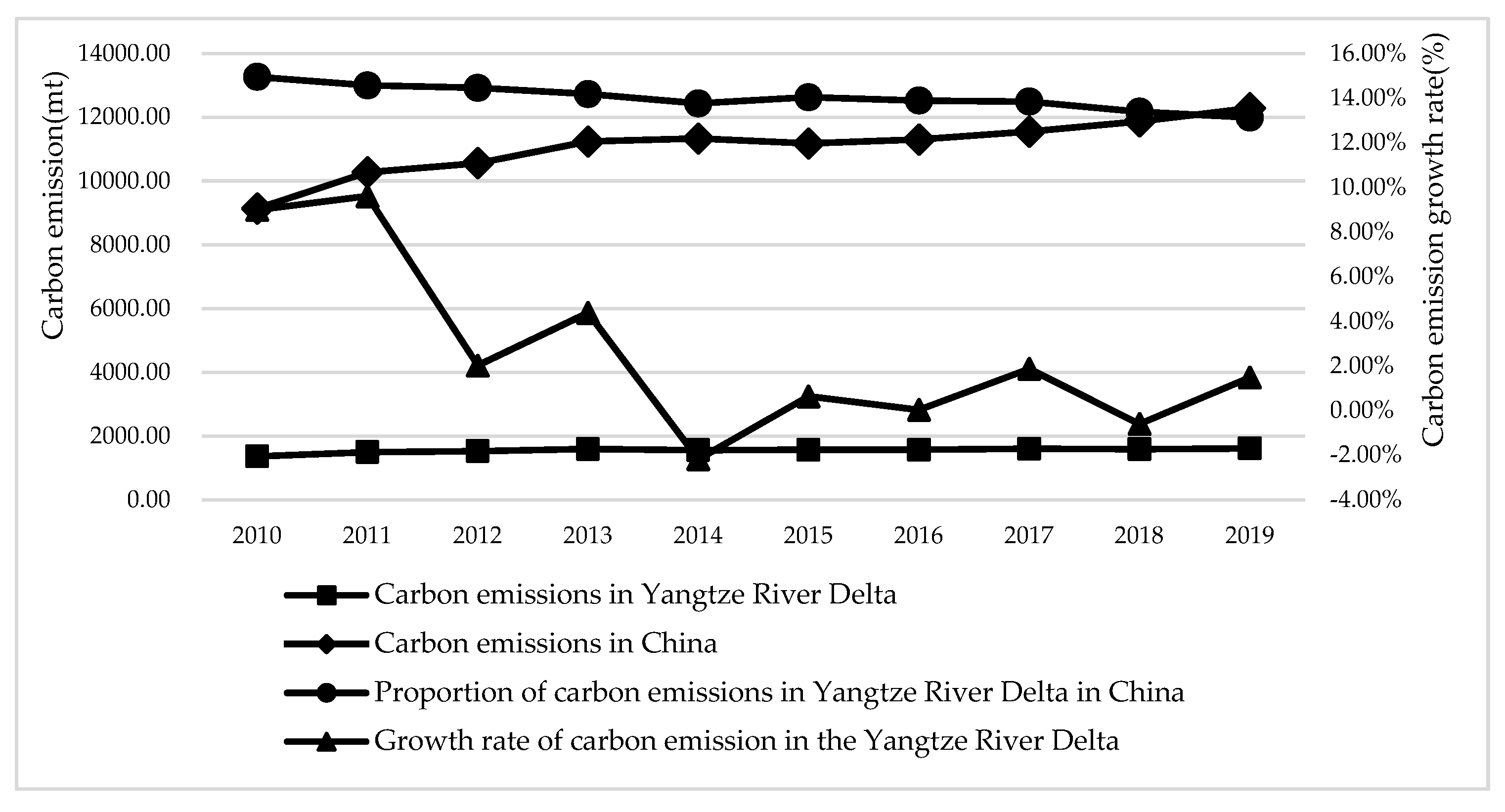
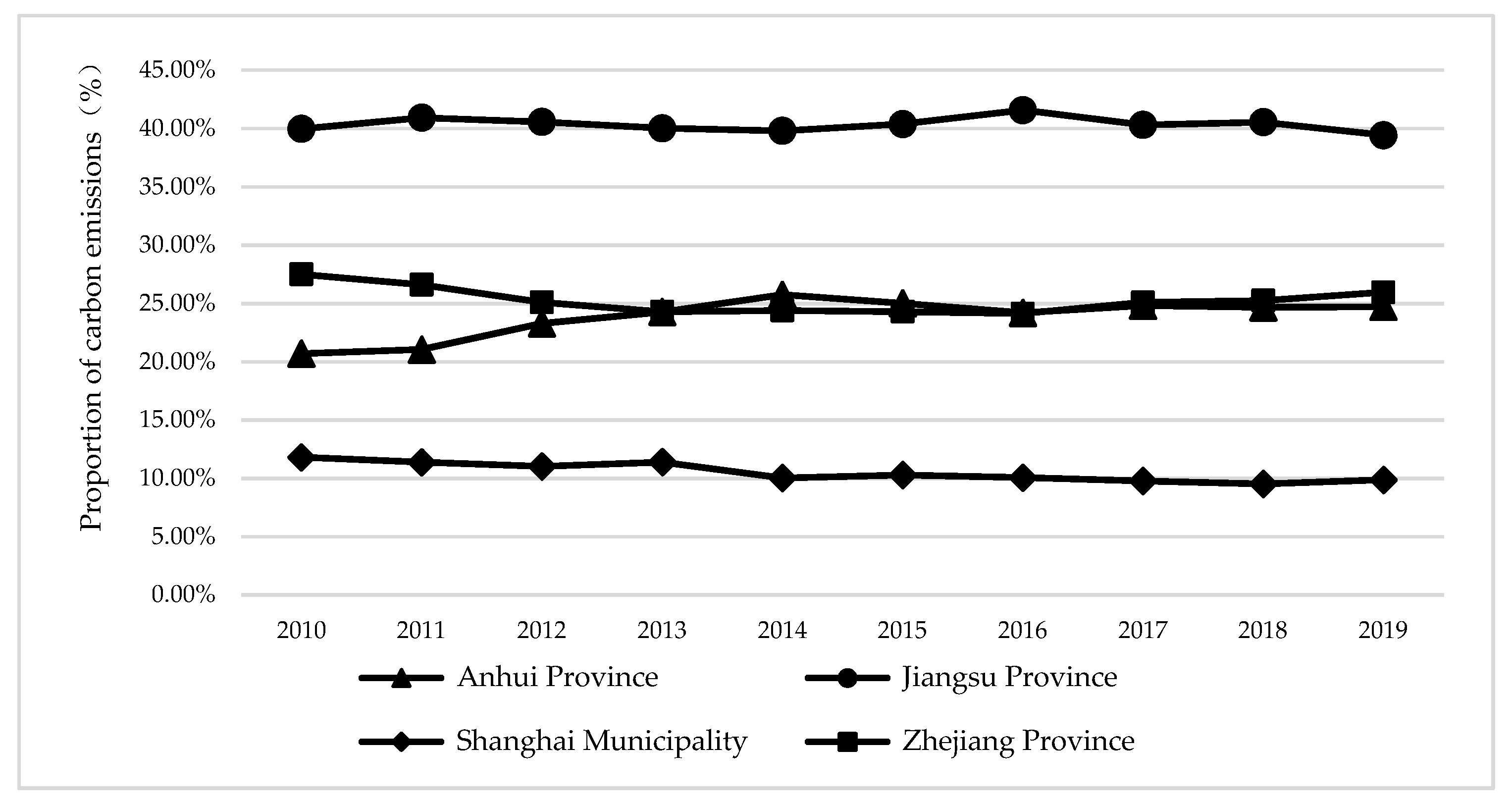
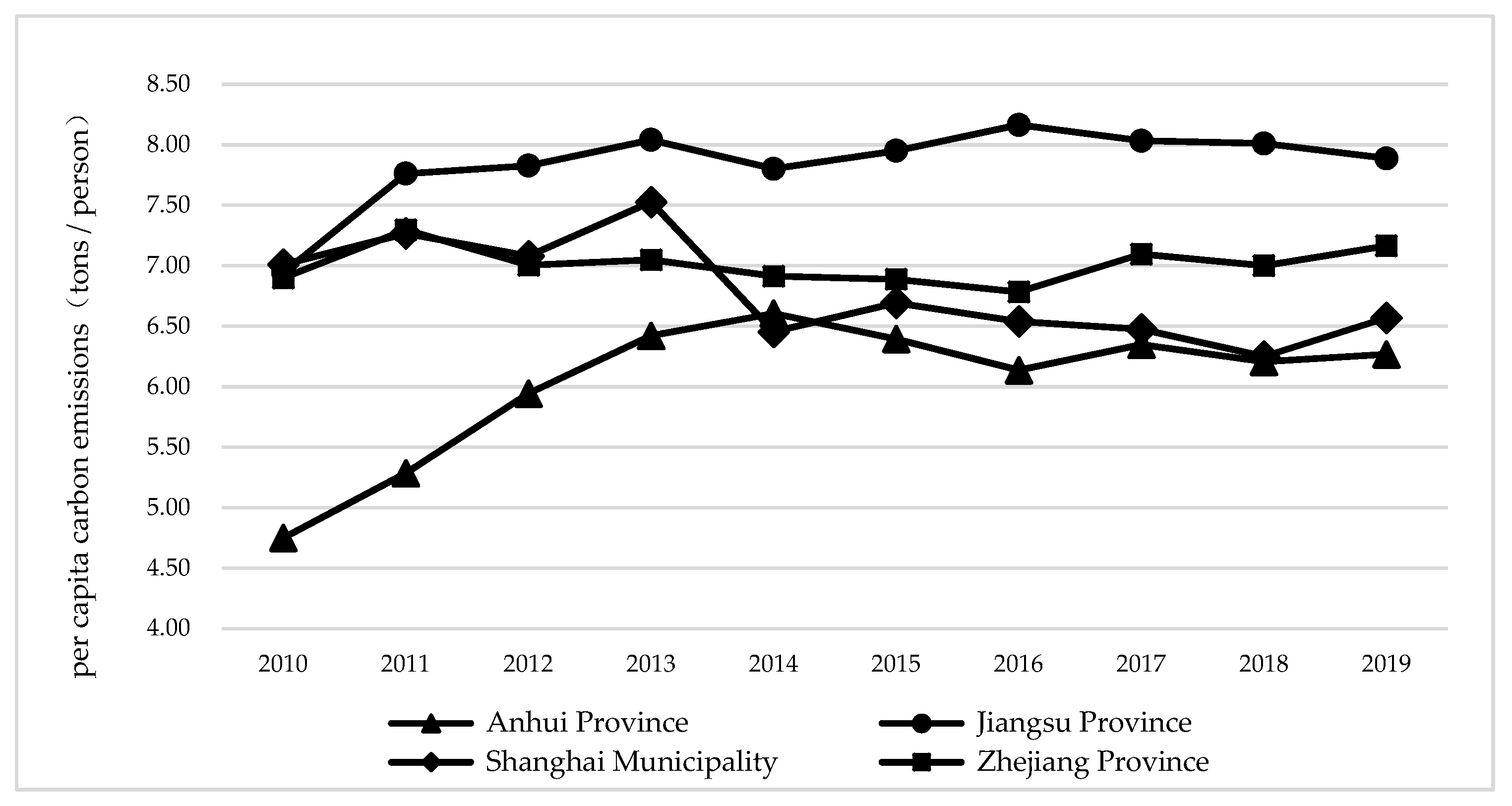

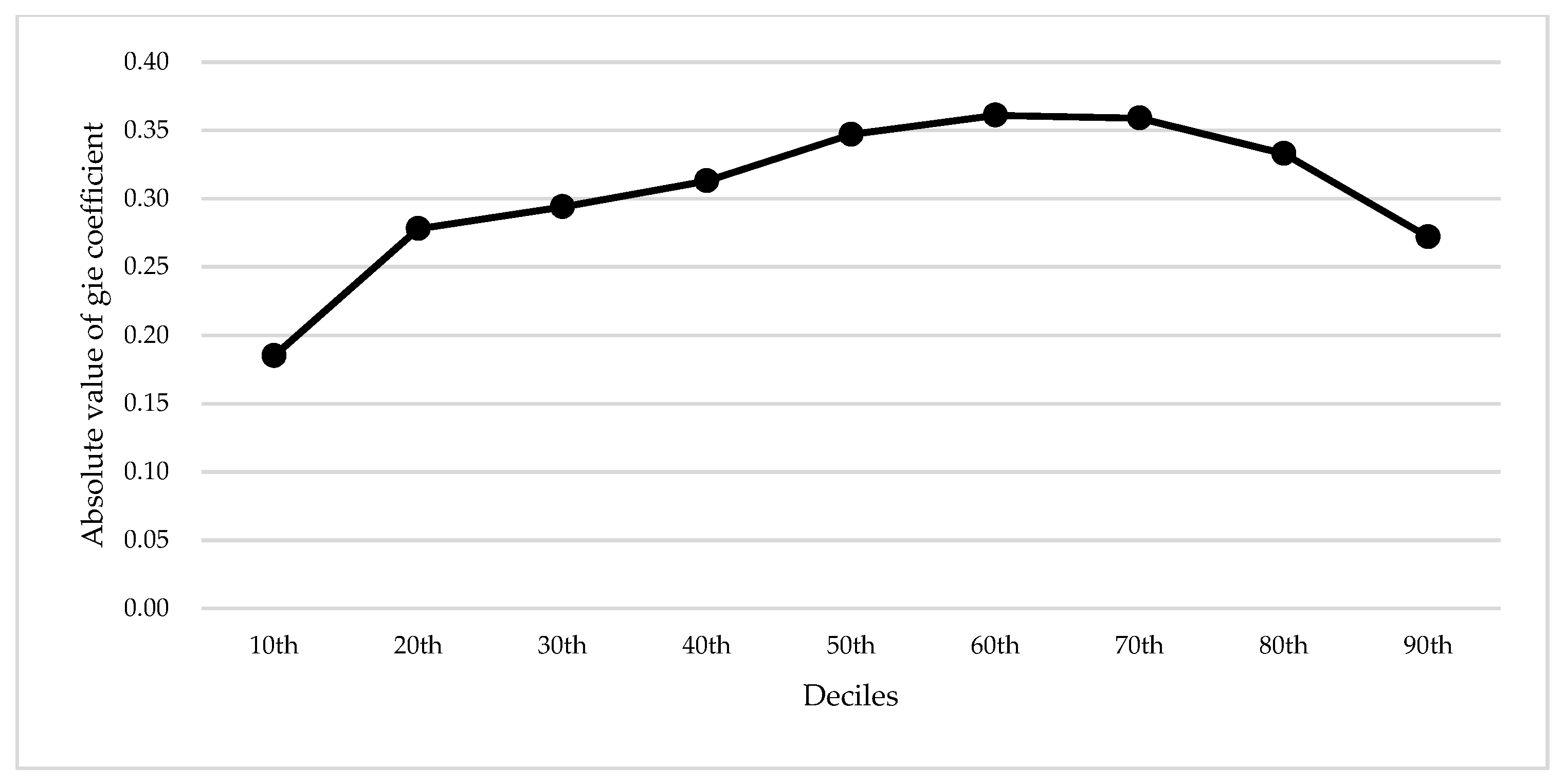
| Primary Index | Secondary Index | Tertiary Indicators | Unit |
|---|---|---|---|
| Input indicators | Human capital | The full-time equivalent of R&D | 10,000 People |
| Capital investment | R&D capital stock | Hundred billion Chinese yuan | |
| Energy input | Total industrial energy consumption | 10,000 tons of standard coa | |
| Output indicators | Expected outputs | The amount of authorized green patents | Piece |
| Sales revenue of new products | Hundred billion Chinese yuan | ||
| Undesired outputs | Industrial waste gas | 10,000 tons | |
| Industrial wastewater discharge | Ton | ||
| Industrial smoke (powder) dust emission | Ton |
| (1) | (2) | (3) | (4) | (5) | |
|---|---|---|---|---|---|
| Variable | I | II | III | IV | V |
| gie | −0.1811 *** (−3.54) | −0.3169 *** (−4.64) | −0.3158 *** (−5.96) | −0.0170 (0.56) | −0.1341 * (−1.91) |
| pgdp | 0.0007 (0.24) | 0.0033 * (1.71) | 0.0026 (1.21) | 0.0011 (0.73) | |
| fdi | 0.0899 ** (2.31) | 0.1001 ** (2.02) | −0.2170 *** (−4.96) | −0.1121 ** (−2.25) | |
| pop_density | 0.2775 *** (3.86) | 0.2110 *** (3.30) | −0.0475 (−0.68) | −0.2479 (−1.13) | |
| produ_aver | 2.0783 *** (4.70) | 1.7502 ** (2.48) | 2.2988 *** (4.18) | 1.2084 ** (2.23) | |
| third_r | 2.5162 ** (−2.08) | 0.6468 (1.39) | 1.9042 ** (2.35) | −1.2504 * (−1.74) | |
| so2 | −1.36 × 10−7 (−1.30) | 7.08 × 10−8 (0.90) | −1.73 × 10−7 (−1.55) | 2.12 × 10−7 * (1.94) | |
| indu_dust | −1.41 × 10−8 (−0.64) | 4.65 × 10−8 * (1.78) | −4.11 × 10−8 * (−1.95) | 1.86 × 10−8 (1.08) | |
| indu_water | −217.5439 * (−1.88) | 217.04 * (1.85) | −526.0929 *** (−3.84) | −269.1283 ** (−2.47) | |
| PM2.5 | −0.0007 (−0.47) | 0.0043 (1.61) | −0.0143 ** (−2.06) | 0.0020 (0.60) | |
| ti | 9.0269 *** (5.26) | 4.6116 ** (2.43) | 5.2227 * (1.97) | 2.7080 (1.45) | |
| firm_gs | 0.0001 *** (8.23) | 0.0002 *** (12.52) | 0.0001 * (1.91) | 0.0001 ** (2.29) | |
| greenland | 0.0458 (0.64) | 0.1145 ** (2.42) | 0.3065 *** (3.28) | 0.0788 (1.22) | |
| year | Yes | No | No | Yes | Yes |
| area | Yes | No | Yes | No | Yes |
| obs | 400 | 400 | 400 | 400 | 400 |
| R2 | 0.0028 | 0.7928 | 0.7285 | 0.5229 | 0.3271 |
| Variable | I | II | III |
|---|---|---|---|
| Instrumental variable | 0.4824 *** (3.54) | - | - |
| gie | - | −0.3729 ** (2.38) | −0.1646 ** (−2.05) |
| pgdp | −0.0022 (−1.21) | 0.0035 (1.05) | 0.0018 (0.98) |
| fdi | 0.1250 *** (3.90) | 0.0143 (0.11) | −0.0985 ** (−2.48) |
| pop_density | −0.1219 * (−1.87) | 0.3424 *** (3.72) | −0.0105 (−0.04) |
| produ_aver | 0.1927 (0.84) | 1.9349 *** (3.99) | 0.7337 * (1.70) |
| third_r | −0.7287 * (−1.81) | 2.9064 *** (4.66) | −1.3794 * (−1.95) |
| so2 | −2.74 × 10−7 ** (−2.19) | −1.36 × 10−7 (−0.39) | 2.33 × 10−7 ** (2.89) |
| indu_dust | −7.17 × 10−9 (−0.46) | −1.47 × 10−8 (−0.59) | 2.28 × 10−8 (1.27) |
| indu_water | −296.1486 *** (−3.66) | −217.5439 * (−1.93) | −264.6146 * (−1.94) |
| pm2.5 | −0.0013 (0.10) | −0.0007 (0.43) | −0.0004 (−1.55) |
| ti | 1.167022 (0.99) | 9.0269 *** (3.82) | 2.67374 (1.50) |
| firm_gs | 0.0001 ** (2.13) | 0.0001 *** (4.23) | 0.0001 * (1.83) |
| greenland | −0.1616 *** (−4.47) | 0.0458 (1.61) | 0.0503 (1.12) |
| year | Yes | Yes | Yes |
| area | Yes | Yes | Yes |
| obs | 400 | 400 | 340 |
| R2 | - | 0.7462 | 0.3255 |
| (1) | (2) | (3) | (4) | |
| Variable | Shanghai | Jiangsu | Zhejiang | Anhui |
| gie | −0.1811 *** (4.02) | −0.0034 (1.23) | −0.1536 * (−1.89) | −0.1144 * (−1.77) |
| control variables | control | control | control | control |
| year | Yes | Yes | Yes | Yes |
| area | Yes | Yes | Yes | Yes |
| obs | 10 | 120 | 110 | 160 |
| Centered R2 | 0.0028 | 0.9587 | 0.9516 | 0.9538 |
| Variable | 10th | 20th | 30th | 40th | 50th | 60th | 70th | 80th | 90th |
| gie | −0.185 * (−1.89) | −0.278 *** (−3.03) | −0.294 ** (−2.55) | −0.313 ** (−2.21) | −0.347 *** (−4.29) | −0.361 *** (−3.47) | −0.359 *** (−3.78) | −0.333 *** (−3.84) | −0.272 ** (−2.38) |
| control variables | control | control | control | control | control | control | control | control | control |
| year | Yes | Yes | Yes | Yes | Yes | Yes | Yes | Yes | Yes |
| area | Yes | Yes | Yes | Yes | Yes | Yes | Yes | Yes | Yes |
| obs | 400 | 400 | 400 | 400 | 400 | 400 | 400 | 400 | 400 |
| Pseudo R2 | 0.5714 | 0.5670 | 0.5564 | 0.5514 | 0.5633 | 0.5839 | 0.6051 | 0.6142 | 0.6298 |
Publisher’s Note: MDPI stays neutral with regard to jurisdictional claims in published maps and institutional affiliations. |
© 2022 by the authors. Licensee MDPI, Basel, Switzerland. This article is an open access article distributed under the terms and conditions of the Creative Commons Attribution (CC BY) license (https://creativecommons.org/licenses/by/4.0/).
Share and Cite
Guo, M.; Cai, S. Impact of Green Innovation Efficiency on Carbon Peak: Carbon Neutralization under Environmental Governance Constraints. Int. J. Environ. Res. Public Health 2022, 19, 10245. https://doi.org/10.3390/ijerph191610245
Guo M, Cai S. Impact of Green Innovation Efficiency on Carbon Peak: Carbon Neutralization under Environmental Governance Constraints. International Journal of Environmental Research and Public Health. 2022; 19(16):10245. https://doi.org/10.3390/ijerph191610245
Chicago/Turabian StyleGuo, Meng, and Shukai Cai. 2022. "Impact of Green Innovation Efficiency on Carbon Peak: Carbon Neutralization under Environmental Governance Constraints" International Journal of Environmental Research and Public Health 19, no. 16: 10245. https://doi.org/10.3390/ijerph191610245
APA StyleGuo, M., & Cai, S. (2022). Impact of Green Innovation Efficiency on Carbon Peak: Carbon Neutralization under Environmental Governance Constraints. International Journal of Environmental Research and Public Health, 19(16), 10245. https://doi.org/10.3390/ijerph191610245




